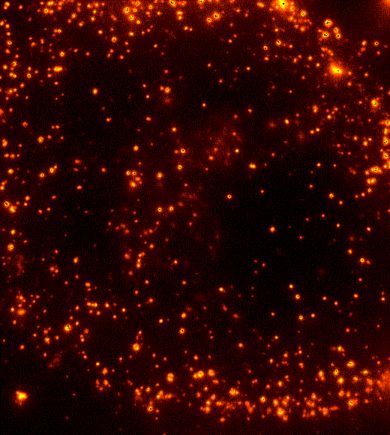Payne Lab: Difference between revisions
| Line 25: | Line 25: | ||
==='''New methods for live cell imaging: Fluorescence microscopy and nanoparticle delivery.'''=== | ==='''New methods for live cell imaging: Fluorescence microscopy and nanoparticle delivery.'''=== | ||
'''Intracellular delivery of nanoparticles.''' | |||
Nanoparticles have important biomedical applications ranging from the treatment of human disease with gene therapy to understanding basic cellular functions with fluorescent probes. For these applications to be fully realized it is necessary to deliver nanoparticles across the plasma membrane and into the cytosol of living cells. The Payne Lab is developing novel methods for the cytosolic delivery and targeting of nanoparticles in conjunction with the use of advanced microscopy techniques to understand the mechanisms of nanoparticle delivery. | |||
The Payne Lab is developing new optical techniques for | '''Fluorescence microscopy in challenging environments.''' | ||
While recent developments in fluorescence microscopy make it possible to image many of the dynamic events that are essential to cellular function, new methods are necessary to observe the dynamics of single molecules inside living cells. Imaging within live cells is difficult as the emission from fluorescent probes competes with the autofluorescence of the cell. The Payne Lab is developing new optical techniques for quantitative cellular imaging. Optical methods of interest include nanometer-level imaging, spectroscopic single-particle tracking, and multiphoton total internal reflection microscopy. | |||
Revision as of 12:23, 19 September 2009

Imaging Reaction Dynamics in Living Cells

Cells are dynamic environments that use carefully regulated mechanisms to maintain function and health. One example of this is the vesicle-mediated transport of lipids (shown to the right). Each bright spot shows a single vesicle as it transports lipids through the cell. Each step of this process; internalization, transport in the vesicle, and enzymatic degradation of the lipids, is controlled by chemical reactions within the cell. Understanding these dynamic processes requires a method that will provide both spatial and temporal information-the ability to watch each step as it occurs. To obtain this information the Payne Lab uses fluorescence microscopy to directly probe intracellular dynamics. The Payne Lab is interested in two related questions; what are the rates and mechanisms of these intracellular processes and how can we better image each event.
Imaging chemical reactions within a cell.
Direct imaging reveals the subcellular location, concentration, and reaction rate of the molecules of interest. These parameters can be measured to determine a complete intracellular reaction mechanism. Specific systems of interest include the degradation of low-density lipoprotein (LDL), transcytosis across the blood-brain barrier, and the intracellular aggregation of proteins. These systems pose a number of biological and physical questions including the mechanism of intracellular transport, kinetics of vesicle fusion, and the influence of the local environment on a chemical reaction.
New methods for live cell imaging: Fluorescence microscopy and nanoparticle delivery.
Intracellular delivery of nanoparticles. Nanoparticles have important biomedical applications ranging from the treatment of human disease with gene therapy to understanding basic cellular functions with fluorescent probes. For these applications to be fully realized it is necessary to deliver nanoparticles across the plasma membrane and into the cytosol of living cells. The Payne Lab is developing novel methods for the cytosolic delivery and targeting of nanoparticles in conjunction with the use of advanced microscopy techniques to understand the mechanisms of nanoparticle delivery.
Fluorescence microscopy in challenging environments. While recent developments in fluorescence microscopy make it possible to image many of the dynamic events that are essential to cellular function, new methods are necessary to observe the dynamics of single molecules inside living cells. Imaging within live cells is difficult as the emission from fluorescent probes competes with the autofluorescence of the cell. The Payne Lab is developing new optical techniques for quantitative cellular imaging. Optical methods of interest include nanometer-level imaging, spectroscopic single-particle tracking, and multiphoton total internal reflection microscopy.